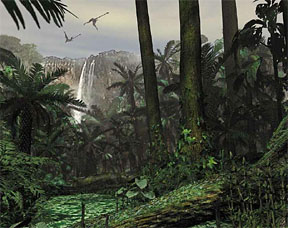Climate Change: Winners and Losers
Lesson 3: Melting Polar Ice
Page 1: Warming Up Page 2 Page 3 Review
Warming Up:
Our story so far: The Earth has bounced back and forth between multi-million-year periods of warm temperatures--called Hothouse Earth--and cooler temperatures, called Icehouse Earth. Currently, we are in an interglacial phase of an Icehouse Earth period. Global temperatures today are below the historical average.

So why should we be concerned that human activity is increasing the greenhouse effect and leading to warmer temperatures?
Not all parts of the Earth will experience the same degree of warming. Temperatures will rise at the Equator, but temperatures will rise even more as you move into higher latitudes--toward the North Pole in the Northern Hemisphere, and toward the South Pole in the Southern Hemisphere.
To understand why, imagine that you are lying in bed in a cold room, and all you have for a cover is a thin sheet. If you lie with your legs straight out, your feet will be colder than your chest and stomach. That's because the upper half of your body generates more heat than the lower half.
As you pile on more blankets to trap the heat given off by your body, the air temperature under the blankets rises and you start warming up. But in addition to trapping more heat and raising the temperature, the extra blankets also spread that heat out more evenly.
Let's say that with only a thin sheet the air temperature was 50ºF around your feet and 58ºF around your chest. You pile on enough blankets so that the temperature around your feet is a comfortable 73ºF and 76ºF around your chest. Both chest and feet areas have gotten warmer, but your feet have gotten 23ºF warmer, while your chest has gotten 18ºF warmer--the colder region of your body has warmed more than the warmer regions.
The greenhouse effect acts like a blanket. It not only raises temperatures on a planet, it also spreads the heat out over the planet and reduces the difference in temperature between the warmest and coolest regions.
You can see this effect in our solar system by comparing the range of temperatures on Mercury, which has almost no atmosphere--meaning it has no greenhouse effect--

and Venus, which has a very thick atmosphere and an extremely powerful greenhouse effect.

Go to this site that compares Surface Temperatures of the Inner Rocky Planets. Calculate the range of temperatures on Mercury. (Since the coldest temperature is below 0º--a negative number--you add the absolute values of the highest and lower temperatures.) Now calculate the temperature range on Venus. That should be a lot easier: 0º(C or F). Imagine covering Mercury with a thick atmosphere like Venus' so that, like Venus, the temperature range was 0º. The coldest regions would warm up a lot more than the warmest regions.
The same pattern will happen on Earth over the next few decades. Temperatures around the Equator will rise, but temperatures around the North and South Poles will rise more. People who live in these higher-latitude areas may welcome this change, but many other people will suffer because of it. To understand why, we will start by looking at glaciers and ice caps.
Go to Page 2